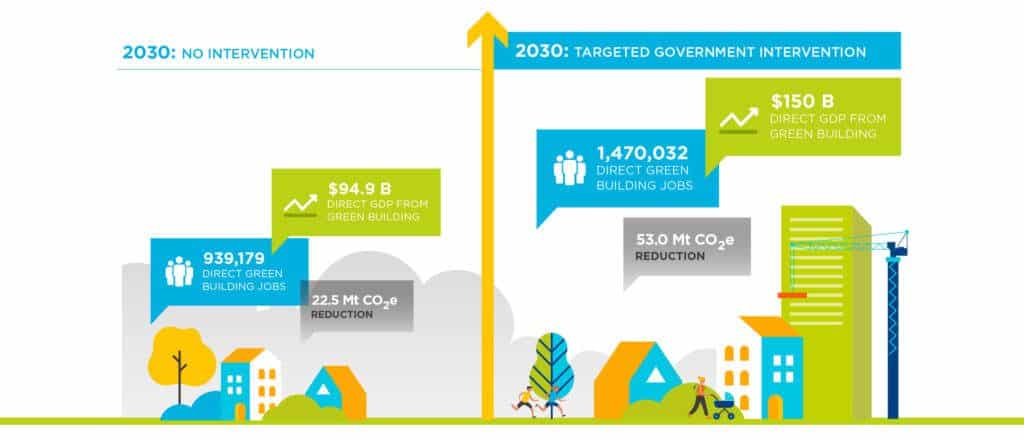Any building can be green
Even older, energy-inefficient buildings can transform into something better. Retrofitting existing buildings can reduce greenhouse gas (GHG) emissions and make them more energy-efficient and healthy for occupants.
According to UN estimates, over half the buildings still in use in 2050 have already been built. Since buildings last so long and contribute to climate change, it is critical to retrofit existing buildings to reduce energy use and carbon emissions.

Rising to the climate challenge
New construction alone isn’t enough to lower Canada’s carbon emissions. Billions of square feet of existing buildings will need to become zero-carbon to help meet the country’s 2030 carbon targets and its 2050 decarbonization goal.
Canada can slash building sector greenhouse gas (GHG) emissions by retrofitting large buildings. CAGBC’s Roadmaps for Retrofits report, retrofits can reduce by up to 21.2 million tonnes of building-sector emissions by 2030.
To speed up zero-carbon retrofits, CAGBC is working with policy-makers and the building sector. Our Zero Carbon Building Program encourages everyone to think about carbon as the key building performance metric, and offers research, education and Zero Carbon Building standards to help accelerate low-carbon retrofits at scale.
Creating green jobs
Retrofitting existing buildings can create jobs that will stay in demand as low-carbon building becomes the norm. We call this the “retrofit economy,” where demand for energy-efficient, low-carbon building retrofits will stimulate job growth and supply chain innovation.
Retrofits can help Canada reignite the economy post-pandemic. In Canada’s Green Building Engine, our research shows the potential of government investment in a green recovery: 1.5 million direct green building jobs and $150 billion in GDP by 2030.

Building a retrofit economy
CAGBC, our members and stakeholders, are building the foundations for a retrofit economy. Here’s how:
Benchmarking
Building owners and managers must know how their buildings perform compared to similar buildings to improve their energy performance and reduce GHG emissions. That’s benchmarking, and it’s a critical part of identifying buildings ripe for retrofit. Benchmarking is great at the building or portfolio level, but policy-makers also benefit from a more macro view across a city, province, or country.
Some of Canada’s leading real estate owners and managers are championing benchmarking and data disclosure through CAGBC’s Disclosure Challenge. By tracking and publicly sharing their portfolio-wide data, other building owners can compare their buildings, making it easier to identify those underperforming against carbon, energy, water, and waste markers.
Financing
Retrofits are necessary to meet Canada’s climate commitments, but they aren’t happening fast enough. One significant barrier is financing. Helping building owners unlock public and private financing could increase the number of building retrofits.
The Investor Confidence Project (ICP) helps make retrofits more attractive to investors. It standardizes how retrofits are planned and developed by using industry best practices to reduce risks and streamline approvals. Projects following the ICP protocols can validate their project using the Investor Ready Energy Efficiency (IREE) certification. Successful projects must pass a third-party review by a qualified Quality Assurance Assessor. This process shows investors that projects have taken the steps necessary to achieve the buildings’ anticipated energy savings.
Workforce
Across Canada, cities have declared climate emergencies and put forward aggressive low-carbon building regulations. Yet, training and education have not kept pace. Getting serious about zero-carbon retrofits requires an investment in the workforce.
CAGBC works with stakeholders to identify gaps in workforce training for low-carbon retrofits and buildings. New skills and the associated training are needed to ensure buildings deliver on planned energy and carbon savings. CAGBC supports the Workforce 2030 coalition, a group of employers, unions, and educators committed to making low-carbon training more accessible. Together, we’re working to expand the existing workforce’s low-carbon skills and knowledge while also growing the workforce through the recruitment of under-represented communities.

